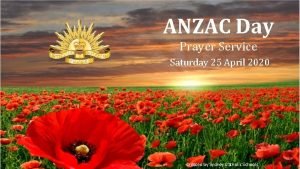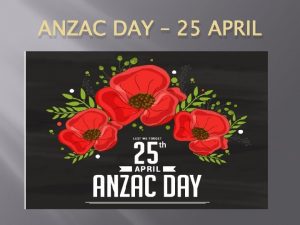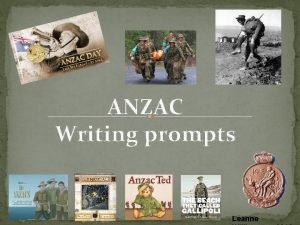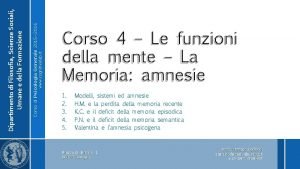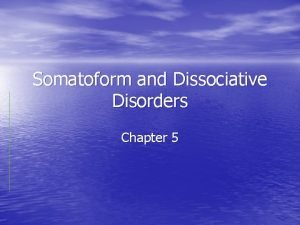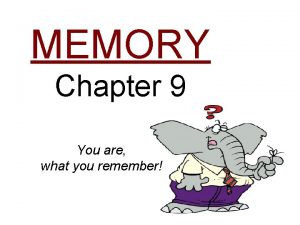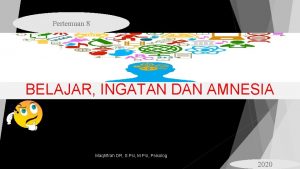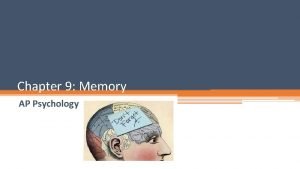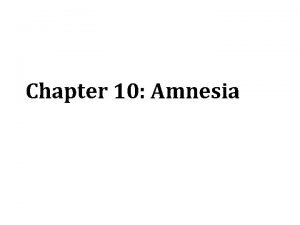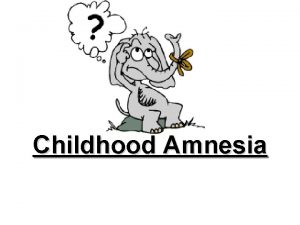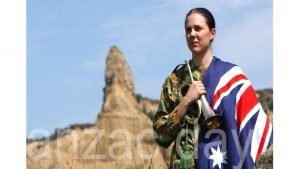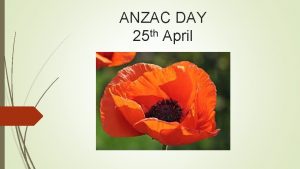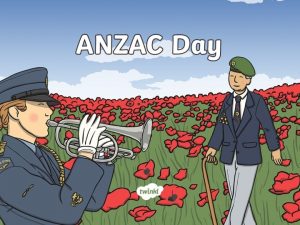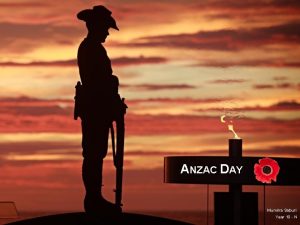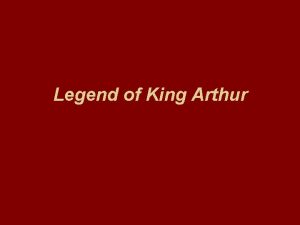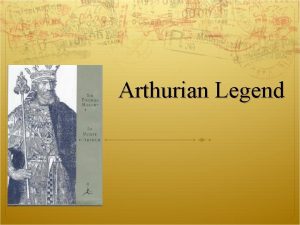The Anzac Legend The Anzac Legend Amnesia seemed


















- Slides: 18

The Anzac Legend

The Anzac Legend Amnesia seemed to be a condition of patriotism…. One of the reasons why Australians after 1918 embraced with such deep emotion the mythic event of Gallipoli, our Thermopylae, was that there seemed to be so little in our early history to which we could point with pride. “History” meant great men, stirring deeds, useful discoveries and worthy sacrifices; our history was short of these Robert Hughes in his introduction to The Fatal Shore¸ Collins Harvill: London, 1987, p. xii.

Australian Historian Russell Ward described the "typical" Australian in his seminal work, The Australian Legend, like this: "A practical man, rough and ready in his manners. He is a great improviser, ever willing to 'have a go' at anything, but … content with a task done in a way that is 'near enough'. Though capable of great exertion in an emergency, he normally feels no impulse to work hard without good cause. He swears hard and consistently, gambles heavily and often, and drinks deeply on occasion … He is a fiercely independent person who hates officiousness and authority … Yet he is very hospitable. "

The Anzac Legend According to the Australian Defence Force, Anzac is: • • Determination to win: Doing your best even when it is difficult and dangerous and you are scared Dedication to duty: making sure that you are always ready to do the best you can in your job as a soldier Honour: you behave properly and within the law towards others, even if they are the enemy you are fighting Integrity: behaving honestly and being trustworthy Mateship and teamwork: Working together as a team and looking after your mates Courage: You try as hard as possible to get what you are after because you believe in what you are fighting for. Initiative: Taking action, being resourceful, and being able to solve problems even if you do not have the right equipment Loyalty and patriotism: Doing what you have to do for the love of your country From Author Unknown, The Spirit of Anzac, Australian War Memorial and the Department of Veteran’s Affairs, Canberra, 2002.

The Home Front • How underlying beliefs systems can influence your interpretation of documents: – Look at these memorials. They depict the more ‘traditional’ image of the Anzac war memorial from WWI. – How could they support Ward’s thesis? In what ways do they ‘resist’ Ward’s thesis? Images of the Beaudesert War Memorial

The Home Front • How underlying beliefs systems can influence your interpretation of documents: – How might Peter Weir’s film Gallipoli, continue to emphasise these underlying values and beliefs? – Is this reinforcing a particular view of our heritage? Images of the Beaudesert War Memorial

The Anzac Legend A history of Anzac in Australia is a series of competing narratives: • Traditional ‘legend of the Digger’ – the Australian Legend

The Anzac Legend A history of Anzac in Australia is a series of competing narratives: • Traditional ‘legend of the Digger’ – the Australian Legend Martin Ball, in an interesting process of textual archaeology shows how the famous final paragraph of Bean’s Official History of Australia, could originally have been the first. Whilst this raises many questions on textual interpretations of Bean’s work as a whole, it is fascinating to see how Bean’s paragraph attempts to give a permanent place in Australian national identity for the participants of the Great War when he states: But the Australian Imperial Force is not dead. That famous army of generous men marches still down the long lane of its country’s history, with bands playing and rifles slung … What these did nothing can alter now. The good and the bad, the greatness and smallness of their story will stand. Whatever of glory it contains nothing now can lessen. It rises, as it will always rise, above the mists of ages, a monument to great-hearted men; and, for their nation, a possession for ever. [1] In this passage, Ball shows how Bean deliberately equates the heroism of the Anzacs with the heroism of the classical accounts of battle by Homer (‘great-hearted’) and Thucydides (‘a possession for ever’). Ball also, through a discussion of the origins of this passage highlights interesting questions as to its origins. Trawling through documents edited in 1919, and the story of Bean’s involvement with his literary editor, Professor Thomas Tucker[2], Ball shows how this passage could actually have been a conceptual framework for Bean’s work from the start rather than merely concluding remarks which gain much more pathos given their publication in 1942 when Australia was already in the depths of another war. Indeed, as these remarks possibly originated in 1919, Ball is given to conclude that ‘it gives more credence to the argument that the whole text is a mythopoeic endeavour, designed to create a homology between Anzac and the nation. ’[3] The heroism of Anzac is reinstated as a dominant national image. Mythopoeic: myth creating [1] Bean quoted in Martin Ball, ‘Re-reading Bean’s Last Paragraph’, Australian Historical Studies, October, no. 122, 2003, p. 231. [2] Martin Ball, ‘Re-reading Bean’s Last Paragraph’, Australian Historical Studies, October, no. 122, 2003, p. 236. [3] Martin Ball, ‘Re-reading Bean’s Last Paragraph’, Australian Historical Studies, October, no. 122, 2003, p. 246.

The Anzac Legend A history of Anzac in Australia is a series of competing narratives: • • Traditional ‘legend of the Digger’ – the Australian Legend National icon – the sacrificial hero Simpson and his donkey: from photograph to memorial. Is it a case of the values of the past becoming the veneer of pastness?

The Anzac Legend A history of Anzac in Australia is a series of competing narratives: • • • Traditional ‘legend of the Digger’ – the Australian Legend National icon – the sacrificial hero The digger-soldier now the digger-peacekeeper From the ‘Rats of Tobruk’ to UN peacekeepers in East Timor?

The Anzac Legend A history of Anzac in Australia is a series of competing narratives: • • Traditional ‘legend of the Digger’ – the Australian Legend National icon – the sacrificial hero The digger-soldier now the digger-peacekeeper Anglo-Celtic ‘dreaming’ – reinforcing a racially tinged approach so as to avoid any firm sense of Australia as a multicultural nation? ‘Australians. . . have no tradition of conquest or imperial ambition’ – PM John Howard, 2003 The photograph accompanying the Sydney Morning Herald article for April 17, 2005 – ‘Bravery of First Anzac to hit the beach at Gallipoli’ – “The first Anzac to hit the beach at Gallipoli was a tough, northern NSW canecutter named Joseph Stratford. ”. Worn with pride. . . William Stratford, 8, with his great uncle's medals. Go to http: //www. smh. com. au/news/National/Bravery-of-first. Anzac-to-hit-the-beach-at. Gallipoli/2005/04/16/1113509969528. html

The Anzac Legend A history of Anzac in Australia is a series of competing narratives: • • Traditional ‘legend of the Digger’ – the Australian Legend National icon – the sacrificial hero The digger-soldier now the digger-peacekeeper Anglo-Celtic ‘dreaming’ – reinforcing a racially tinged approach so as to avoid any firm sense of Australia as a multicultural nation? ‘Australians. . . have no tradition of conquest or imperial ambition’ – PM John Howard, 2003 • Foot soldier for, firstly, the British Empire and then the American (USA) Empire The Australians still had to charge despite the ‘fact’ that ‘The British have landed at Suvla [Bay] and are drinking tea’ – from Weir’s film Gallipoli Former PM John Howard visiting Australian troops in Baghdad, Iraq, 2005

The Anzac Legend A history of Anzac in Australia is a series of competing narratives: • • Traditional ‘legend of the Digger’ – the Australian Legend National icon – the sacrificial hero The digger-soldier now the digger-peacekeeper Anglo-Celtic ‘dreaming’ – reinforcing a racially tinged approach so as to avoid any firm sense of Australia as a multicultural nation? ‘Australians. . . have no tradition of conquest or imperial ambition’ – PM John Howard, 2003 • • Foot soldier for, firstly, the British Empire and then the American (USA) Empire Gendered history – the myth of the male, dead hero; the silencing of the female voice in Australian history; the physical impossibility of males giving ‘birth’ to a nation/national identity, but linguistically possible through a softening of the harsher features of the dead male through use of language eg. referring to a ‘landing’ rather than an invasion; the concept of a ‘mate/mateship’, as a core value of Anzac

The Anzac Legend A history of Anzac in Australia is a series of competing narratives: • Gendered history – the myth of the male, dead hero; the silencing of the female voice in Australian history; the physical impossibility of males giving ‘birth’ to a nation/national identity, but linguistically possible through a softening of the harsher features of the dead male through use of language eg. referring to a ‘landing’ rather than an invasion; the concept of a ‘mate/mateship’, as a core value of Anzac ‘Washing Day’, Khaki and Green, Australian War Memorial, Canberra, 1943, p. 78.

The Anzac Legend For homework… A history of Anzac in Australia is a series of competing narratives: • • View the following youtube clip that was posted by a member of the public on the death of Alec Campbell, the ‘last Anzac’ http: //www. youtube. com/watch? v=E 9 A 4 ARtbm. Fk How does this clip express the dominant reading of Anzac heritage? How are other aspects of Anzac history silenced or marginalised by this type of ‘memorial’? Is this example of Anzac heritage emphasising values, things or veneer? ‘Washing Day’, Khaki and Green, Australian War Memorial, Canberra, 1943, p. 78.

The Anzac Legend Anzac and the Military tradition – the narrative of Anzac • Points from Ken Inglis’ article ‘Anzac and the Military Tradition’ – The essence of a ‘tradition’ - must have an accepted core for a tradition to live – Inglis identifies comradeship, loyalty to mates, initiative, individuality eg. Pvte Albert Jacka, winner of the VC for an awesome single-handed defeat of killing Turks and Pvte John Simpson, of donkey fame • • The language of Anzac – an acronym turns into a word Memories of childhood – schools and Anzac From WWI to WWII – Gallipoli to Kokoda Demolition in Vietnam It was a sign of the Americanisation of Australian warfare that men back from Vietnam were commonly called not “returned soldiers”, the old Australian term, but “veterans”, the American word’ (p. 13) – is the reclamation of Anzac Day in the 21 st century an attempt to reclaim a national tradition in the face of rampant US-led globalisation? • Literature and film – the myth of the male, dead hero • Feminists and Anzac – a male story

The Anzac Legend Anzac and the Military tradition – the narrative of Anzac Much of the power that history exerts in popular culture comes from its ability to create a shared past. That social memory, the sense of sharing in past events even when the individuals were not participants in or even witnesses to them, is a powerful force in the construction of group identity, and in defining who the group includes and excludes R. White, ‘National Days and the National Past in Australia’, p. 55 Consider: How do our memorials reinforce the dominant discourse that we, as Australians, wish to remember about ‘Anzac’? In what ways do our memorials marginalise alternative perspectives and push individuals to the ‘periphery’ of Australian society? Has the ‘dominant reading’ of Anzac expanded since WWI or do our memorials allow for alternate readings and the inclusion of marginalised members of Australian society?

The Anzac Legend Anzac and the Military tradition – the narrative of Anzac Much of the power that history exerts in popular culture comes from its ability to create a shared past. That social memory, the sense of sharing in past events even when the individuals were not participants in or even witnesses to them, is a powerful force in the construction of group identity, and in defining who the group includes and excludes R. White, ‘National Days and the National Past in Australia’, p. 55 Useful articles to read: R. White, ‘National Days and the National Past in Australia’ K. Inglis, ‘Anzac and the Military Tradition’ C. Barrett and M. Crotty. , ‘Anzac: the cynics, the sacred and the secular’
 Anzac day prayer
Anzac day prayer Why do we celebrate anzac day
Why do we celebrate anzac day Anzac day writing prompts
Anzac day writing prompts Amnesia
Amnesia Types of amnesia
Types of amnesia Amnesia anonymization tool
Amnesia anonymization tool Source amnesia
Source amnesia Anonymization tool
Anonymization tool Amnesia proactiva
Amnesia proactiva Doppia dissociazione memoria
Doppia dissociazione memoria Source amnesia
Source amnesia Source amnesia
Source amnesia Anterograde amnesia
Anterograde amnesia Ci normal
Ci normal Dissociative amnesia
Dissociative amnesia Anterograde amnesia
Anterograde amnesia Dissociative fugue
Dissociative fugue Amnesia lobus temporal medial
Amnesia lobus temporal medial Misattribution psychology
Misattribution psychology
